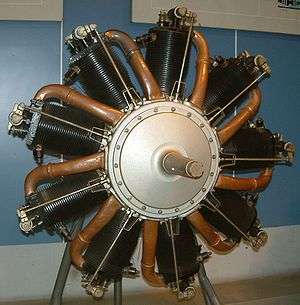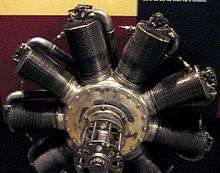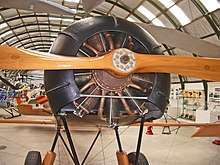Le Rhône
Le Rhône was the name given to a series of popular rotary aircraft engines produced in France by Société des Moteurs Le Rhône and the successor company of Gnome et Rhône. They powered a number of military aircraft types of the First World War. Le Rhône engines were also produced under license worldwide.
| Le Rhône | |
|---|---|
 | |
| 80 hp Le Rhône Model 9C, showing forward-mounted induction piping | |
| Type | Rotary engine |
| Manufacturer | Gnome et Rhône |
| First run | 1910 |
Although not powerful (the largest wartime version produced 130 horsepower (97 kW)), they were dependable rotary engines.[1] The Le Rhône 9 was a development of the Le Rhône 7, a seven-cylinder design. Examples of nine-cylinder Le Rhône rotary engines are on public display in aviation museums with several remaining airworthy, powering vintage aircraft types.
Operation
In most respects the Le Rhône engines were typical rotary engines, so that the crankshaft remained stationary in operation, with the entire crankcase and its attached cylinders rotating around it as a unit.
The copper induction tubes had their crankcase ends located in different places on the 80 and 110 horsepower (60 and 82 kW) versions; the 80 hp versions had them entering the crankcase in a location forward of the vertical center-line of each cylinder, while the 110 hp version had them located behind the cylinder's center-line. This resulted in the 80 hp version's intake plumbing being "fully visible" from the front, while the 110 hp version had the lower ends of its intake tubes seemingly "hidden" behind the cylinders.
A complicated slipper bearing system was used in the Le Rhône engine. The master rod was of a split-type, which permitted assembly of the connecting rods. It also employed three concentric grooves, designed to accept slipper bearings from the other cylinders. The other connecting rods used inner-end bronze shoes, which were shaped to fit in the grooves. The master rod was numbered as number one and the shoes of numbers two, five and eight rode in the outer groove, the shoes of three, six and nine in the middle groove and four and seven in the inner groove. Although this system was complex, the Le Rhône engines worked very well.[1][2]
The Le Rhône engines used an unconventional valve actuation system, with a single centrally-pivoting rocker arm moving the exhaust valve and the intake valve. When the arm moved down it opened the intake valve and when it moved up it opened the exhaust valve. To make this system work a two-way push-pull rod was fitted, instead of the more conventional one-way pushrod. This feature required the cam followers to incorporate a positive action, a function designed in by using a combination of links and levers. This design prevented valve overlap and so limited power output, but as the engine structure and cooling arrangements would not have been adequate at a higher power output, this should not be considered a significant design fault.[1]
Production
As well as production by Société des Moteurs Gnome et Rhône, which had bought out Société des Moteurs Le Rhône in 1914, the Le Rhône was produced in Germany (by Motorenfabrik Oberursel), Austria, the United Kingdom (by Daimler), Russian Empire and Sweden.
80 hp (60 kW) le Rhône engines were made under license in the United States by Union Switch and Signal of Pennsylvania, and the 110 hp (82 kW) Oberursel Ur.II rotary engine used by Germany in World War I, in such famous fighters such as the Fokker Dr.I triplane, was a close copy of the 110 hp (82 kW) le Rhône 9J version.[1]
Variants
Data from :[3]

- Le Rhône Type 7A
- (1910) 50 hp (37 kW) , seven-cylinder rotary engine — twenty built for use on Borel Monoplanes and Sommer Biplanes.
- Le Rhône Type 7B
- (1911) 50 hp (37 kW), seven-cylinder rotary engine — Thirty-five prototype engines built.
- Le Rhône Type 7B2
- (1912) 60 hp (45 kW), seven-cylinder rotary engine — 350 built at Societe Moteurs le Rhône.
- Le Rhône Type 7Z
- 40hp
- Le Rhône Type 9C
- (1916) 80 hp (60 kW), nine-cylinder rotary engine.
- Le Rhône Type 9J
- (1913) 110 hp (82 kW), nine-cylinder rotary engine.
- Le Rhône Type 9Ja
- (1915) 110 hp (82 kW), nine-cylinder rotary engine.
- Le Rhône Type 9Jb
- (1916) 120 hp (89 kW), nine-cylinder rotary engine.
- Le Rhône Type 9Jby
- (1916) 130 hp (97 kW), nine-cylinder rotary engine.

- Le Rhône Type 9R
- (1916) 170 hp (130 kW) / 180 hp (130 kW) 9-cylinder rotary.
- Le Rhône 9Z
- (1920) A 60 hp (45 kW) 9-cylinder rotary.
- Le Rhône 11F
- (1913) A 100 hp (75 kW) 11-cylinder rotary.
- Le Rhône 14D
- (1912) A 120 hp (89 kW) two-row rotary, consisting of two seven-cylinder rows rotating round a single two-throw crankshaft.
- Le Rhône 18E (1912)
- (1912) A 160 hp (120 kW) two-row rotary, consisting of two nine-cylinder rows rotating round a single two-throw crankshaft.
- Le Rhône 18E (1917)
- (1917) A 340 hp (250 kW) two-row rotary, consisting of two 9R rows rotating round a single two-throw crankshaft.
- Le Rhône 28E
- (1918) A 320 hp (240 kW) four-row rotary, consisting of four seven-cylinder rows rotating round a single four-throw crankshaft.
- Le Rhône K
- (1916) A 9-cylinder rotary prototype engine.
- Le Rhône L
- (1916) A 9-cylinder rotary prototype engine.
- Le Rhône M
- (1917) A 9-cylinder rotary engine produced in small quantities.
- Le Rhône P
- (1917) A 9-cylinder rotary prototype engine.
- Le Rhône R
- (1917) A 9-cylinder rotary prototype engine.
- Oberursel Ur.II
- A clone of the Le Rhône 9J
- Oberursel Ur.III
- An 11 cylinder German development of the Ur.II (Le Rhône 9J).
Oberursel copy
Oberursel produced the 110 hp model, supposedly without authorization in Germany.[4] The Oberursel Ur.II was a straight copy of the Le Rhône, but the Le Rhône was preferred over the Oberursel due to the materials used in the French product. However, by July 1918 there was a shortage in Germany of castor oil,[1] a plant-derived lubricant that the rotaries required, as it could not be easily dissolved into the fuel and because it possessed lubrication qualities superior to mineral oils of the day.[5] A new Voltol-based lubricant, derived from mineral oil, was substituted and was blamed for engine failures on German fighters such as the Fokker E.V, which used the Oberursel Ur.II. It has been suggested that without proper lubricants, the Le Rhône rotary would have been equally failure-prone.[1]
A reproduction of the Oberursel has been manufactured by The Vintage Aviator Company in New Zealand in very limited numbers by reverse engineering an original Oberursal engine, presumably for their own project aircraft. The engine has been test-run and is described at http://thevintageaviator.co.nz/projects/oberursel-engine/oberursel-ur-ii-rotary-engine-build-history.[6]
Le Rhônes still flying today
Several enthusiasts are using original Le Rhône engines for World War I replica aircraft today. A flying example can be seen at the Pioneer Flight Museum, Kingsbury Texas in a replica Fokker Dr 1. pioneerflightmuseum.org The engine had previously been flown in an original Thomas Morse Scout, which is now under restoration with another Le Rhône 80 hp engine planned for that flying aircraft. There are other reproductions of Dr 1's flying original Le Rhône engines, as well as the restored Thomas Morse Scouts in the United States.
Applications

.jpg)
- Adamoli-Cattani fighter
- Airco DH.5
- Avro 504
- Bristol M.1
- Bristol Scout
- Caudron G.3
- Caudron G.4
- Hanriot HD.1
- Fokker Dr.I
- Cierva C.6, autogyro, 1924
- Macchi M.14
- Morane-Saulnier N
- Mosca MB 2 bis
- Nieuport 10
- Nieuport 11 "Bebe"
- Nieuport 16
- Nieuport 17, 21 & 23
- Nieuport 24 & 24bis
- Nieuport 27
- Sopwith Camel
- Sopwith Pup
- Standard E-1
- Texas-Temple prototype
- Thomas-Morse S-4C
References
Notes
- Le Rhone Rotary Engine Retrieved on 18 February 2009.
- Gunston 1989, p.93.
- Hartmann, Gérard. "Moteurs de légende : Le Rhône" (PDF) (in French). hydroretro.net. Retrieved 25 December 2013.
- Gunston 1989, p. 73.
- General rotary engine lubrication information from Gnome Monosoupape Type N Rotary Retrieved on 18 February 2009.
- Oberursel UR-II Rotary Engine on YouTube
Bibliography
- Hartmann, Gérard. "Moteurs de légende : Le Rhône" (PDF) (in French). hydroretro.net. Retrieved 25 December 2013.
- Gunston, Bill. World Encyclopedia of Aero Engines. Cambridge, England. Patrick Stephens Limited, 1989. ISBN 1-85260-163-9
External links
| Wikimedia Commons has media related to Le Rhône aircraft engines. |